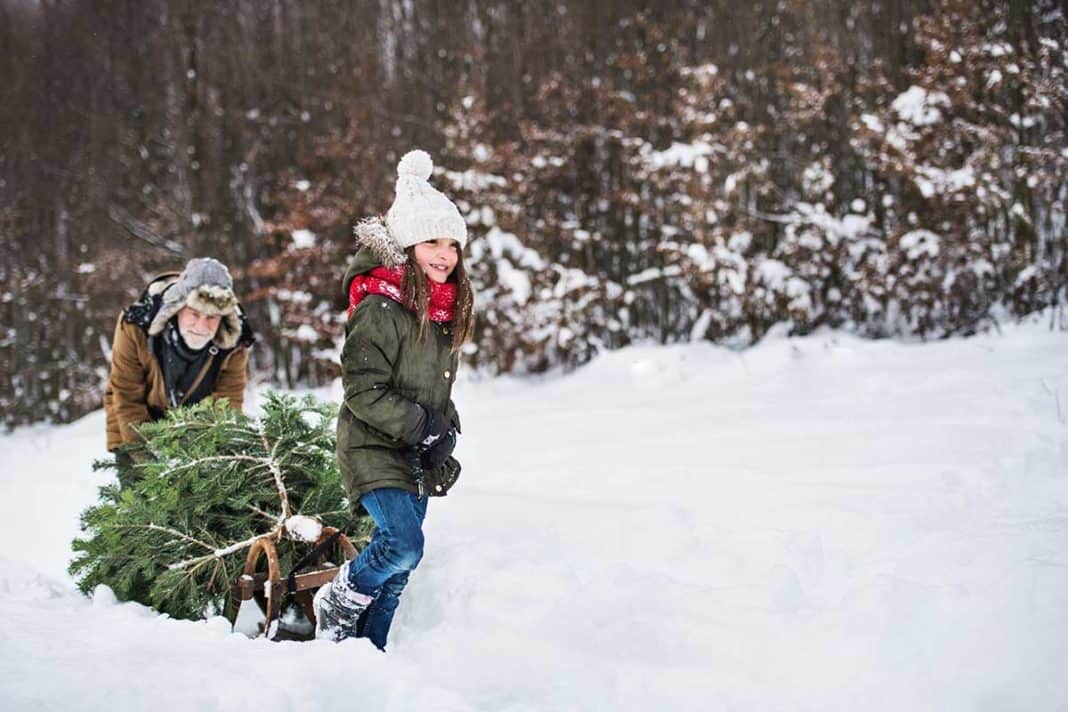MANITOULIN – A traditional Christmas may be a little challenging this year because of COVID-19, but we’re still hanging up the lights, decorating our homes and, of course, trimming those trees. Every year the argument arises: real or artificial? Even the Christmas tree we choose has an impact on our environment.
The Expositor spoke with Shirley Brennan, executive director of Christmas Tree Farmers of Ontario, about why real Christmas trees are an environmentally friendly choice.
“We work hard at growing a product that is healthy for the environment,” said Ms. Brennan. “We’re always looking for ways to help whether it is through ecological transformation and restoration or whether it is through recycling programs after the season.”
Christmas trees are 100 percent recyclable and biodegradable. Most people know this, but what some people don’t know is how much oxygen an acre of Christmas trees can provide. “Each acre provides enough oxygen to support 18 people,” she said. Trees stabilize soil, provide wildlife habitat and absorb carbon dioxide as well.
A 2009 Ellipsos study found that Christmas trees can sequester nearly one ton of carbon dioxide per acre, depending on the type of tree and growing conditions. “The trees provide purified water into the air through transpiration and cultivated fields help filter fresh water supplies as well,” Ms. Brennan added. “We work with different streams and organizations to not only put habitat there, but also to help the restoration of streams and rivers to help prevent eroding. A field of Christmas trees will help with flooding. After the snow thaws, the trees cut down on the amount of flooding because of the type of roots and the ground around Christmas trees.”
Sales of real Christmas trees at Ontario farms have jumped 25 percent this year. People are seeing a trip to the tree farm as a way of getting outdoors and sharing family activities while social distancing due to COVID. If demand remains high there will likely be a shortage of certain species, including the popular Fraser fir. After all, it takes 10 to 15 years before a Christmas tree can be harvested, depending on species and conditions.
Species vary across Ontario but the most common is the Fraser fir, although many Ontario farmers have begun to branch out into different firs. The trees are started from seed and then transplanted as seedlings. A single weather event can wipe out mature trees, such as the June 2016 winter storm in Nova Scotia that destroyed mature trees as well as seedlings.
Real trees may not be completely environmentally friendly. Small amounts of fertilizer and pesticides are used on tree farms if necessary, Ms. Brennan said. Mowing between rows and keeping the grasses and weeds around the trees down minimizes the leaching of nutrients. “If we do have to use pesticides it’s sparingly because we have a product that takes 10 years to grow. We don’t want to damage it so the amount we use is very minute. Most of our farmers mow and keep the weeds down by hand. We do a lot of stuff by foot and by hand on Christmas tree farms.”
It’s a crop like any other crop. “We’re not going out to the forest and cutting trees down. We’re growing trees and for those 10 years the trees provide habitat for small animals and birds. We provide those benefits for 10 years and you have to remember: every time we cut down a tree we plant two more. Not every seedling is going to make it. We’re always putting back into the soil. We may cultivate that soil and bring in another crop so we’re not just replanting the same crop year after year and we’re not draining those nutrients.”
Also, many Christmas tree farms are located on marginal lands where no other crops will grow successfully, but Christmas trees seem to do really well there. This helps to maintain green spaces. Whether or not you can grow fir trees depends on the soil type so if the soil doesn’t support fir trees then those farms would grow spruce and pine trees, she said.
“We certainly hear that question (real or artificial), but we know we have a good product that is 100 percent recyclable, 100 percent biodegradable and provides benefits before we harvest it. We’re not just clearing land. If you go to a Christmas farm today, a section may be cleared but another section is still in the process so that we are always turning over and cultivating that land so we’re not just taking from the land.”
Once Christmas is over, the trees can continue to give back to the environment if they are composted or left to biodegrade. Many municipalities have a recycling program of some type and even sell the recycled trees back to the community as mulch, often as a fundraiser for local organizations. Recently, farmers have been partnering with organizations that improve rivers or streams, or wildlife rescues that use trees for mulch, food or habitat. “We certainly have a lot of options when it comes to recycling,” said Ms. Brennan. “If you have the land to let it biodegrade then wild animals will come and enjoy it as well so that’s also giving back to the wilderness. It’s amazing for birdwatching. I sit by my window and watch the birds that come to my feeder and after Christmas my tree goes out there as well. Not only do they enjoy the food, they use it as shelter as well.”
Not everyone can have a real tree in their home. For example, someone in the family could have allergies. Artificial trees are more convenient, with a variety of styles, colours and sizes available. Some trees come pre-decorated or pre-lit. A good quality artificial tree could last 10 or more years and never has to be watered.
Artificial trees are made from non-renewable resources, however. Most are made from PVC, a petroleum-based plastic that contains phthalates, chemicals which have been proven to be harmful to humans. They tend to come wrapped in plastic as well.
Artificial trees have higher greenhouse gas emissions throughout the manufacturing, packaging and shipping cycle. Artificial trees need to be reused for 20 years to compare favourably with real Christmas trees. The Ellipsos study reported that on average, households replace an artificial tree every six years.
Overall, real Christmas trees are a better option for a lower environmental impact. Other options include buying a second-hand artificial tree; getting crafty with greenery sourced from your own backyard; choosing a live, potted tree that you can plant in the spring; or simply decorating your outdoor trees instead.






